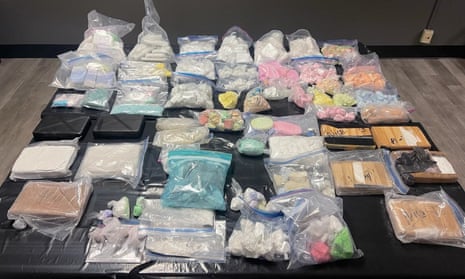Joe Biden’s call for stronger penalties to crack down on fentanyl trafficking during the his State of the Union address last week drew mixed responses from experts.
On Tuesday, the president laid out a series of measures to combat the country’s overdose crisis including increased drug detection machines, cargo inspections and harsher penalties surrounding fentanyl trafficking.
Biden also said that there was currently a “record number of personnel working to secure the border … seizing over 23,000lbs of fentanyl in just the last several months”.
Experts since then have leveled criticism and praise at Biden. In 2021, when an estimated 107,000 people in the US died from drug overdoses, he became the first president whose administration launched a national plan prioritizing harm reduction policies – which include distributing strips that can detect the presence of fentanyl in substances and prevent overdoses – in attempts to prevent death and illness among drug users.
Some harm reduction advocates worry that the Biden administration’s proposal of “strong penalties to crack down on fentanyl trafficking” may frame the crisis as a largely law enforcement and border patrol issue, as opposed to a nationwide public health problem.
“Criminalization of drug use trafficking is the opposite of harm reduction,” the National Harm Reduction Coalition’s director of overdose prevention policy and strategy, Mary Sylla, said. “It’s kind of disheartening because President Biden did use the phrase ‘harm reduction’ last year in his State of the Union address and it was the first time harm reduction had ever been mentioned in the State of the Union address so we were excited to see that.”
Sylla added that criminalizing drugs would have already reduced trafficking or overdoses if it was possible for such an action to do that. It hadn’t done that – or incentivized behavior change among drug users – because it can’t, she said.
Sylla also said that putting people in jail for whatever reason increases their risk “of all kinds … [of] health problems” given the often crowded settings in lockups and prisons.
Other harm reduction advocates argue that Biden’s call for greater penalties will further hit marginalized communities that have already been disproportionately affected by the failed “war on drugs”. They also believe it will allow for even more potent drugs to enter illegal markets.
“His support for harsher penalties for fentanyl-related substances – which will result in broader application of mandatory minimum sentencing and disproportionately harm Black, Latinx and Indigenous communities – in the same breath is incredibly counterproductive and fails to recognize how we got to this place to begin with,” the Drug Policy Alliance’s director of the office of federal affairs, Maritza Perez Medina, said.
Perez added: “The reason fentanyl-related substances have overtaken our drug supply at this point is because of the drug trade responding to harsh crackdowns and increased seizures of heroin and prescription opioids. And now that we are seeing harsher policies towards fentanyl, there are new and even more potent drugs, such as Xylazine and nitazenes popping up and beginning to overtake some markets.”
Perez also criticized the Biden administration’s push for Congress to permanently categorize all fentanyl-related substances as schedule I drugs, a category reserved for drugs that have a high potential for abuse and can create severe psychological and physical dependence.
Schedule I drugs currently include heroin, lysergic acid diethylamide (LSD) and marijuana. Medina said adding fentanyl-related substances to that list without fully testing or researching them is “creating the conditions for a riskier drug market and backtracking on his commitments to criminal justice reform” while also missing the opportunity to find more therapeutic treatments aimed at addressing the overdose epidemic.
At least one therapeutic – naloxone – has already delivered promising results as a tool to reverse opioid overdoses, Medina said. But, Medina and others reiterated, there could be more.
Meanwhile, other experts have praised the Biden administration’s approach to the overdose crisis, which includes disrupting the drug’s trafficking and sale while also expanding access to treatment, recovery and harm reduction tools such as sterilized needles and smoking equipment.
“I think from a broad perspective, we’re on the right track,” Professor Erin Winstanley of West Virginia University – whose focuses include the opioid epidemic and substance use disorders – said.
Winstanley said reducing the supply of dangerous and potent drugs like fentanyl has to be a dimension of any good drug policy. And she said the Biden White House’s list of recommendations to reduce illicit fentanyl-related substances, as submitted to Congress in 2021, took into consideration precisely how prone those drugs are to being abused and proposed their schedule accordingly.
“It’s actually very rational,” Winstanley said. “Any criminal sentencing around fentanyl is linked to in part that research and also the schedule, so that looks quite progressive to me if that’s what ends up being the policy.”
Nevertheless, Winstanley wants to see the Biden administration continue prioritizing science, especially by ensuring that research surrounding substance use disorders continues to have bipartisan support.
“It’s something that we need to continue to ensure that there’s adequate funding so that we can find science-based solutions,” Winstanley added. “Since more deaths in the United States involve fentanyl and methamphetamine, we really need to see further advances in treatment for methamphetamine use disorder and … advancing more sophisticated approaches to managing overdoses involving potent synthetics like fentanyl.”
